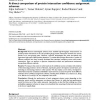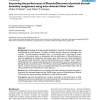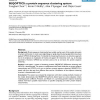BMCBI
2006
14 years 15 days ago
2006
Background: Recent technological advances have enabled high-throughput measurements of protein-protein interactions in the cell, producing large protein interaction networks for v...
BMCBI
2006
14 years 15 days ago
2006
Background: Recognition of relevant sequence deviations can be valuable for elucidating functional differences between protein subfamilies. Interesting residues at highly conserve...
BMCBI
2006
14 years 15 days ago
2006
Background: The residue-wise contact order (RWCO) describes the sequence separations between the residues of interest and its contacting residues in a protein sequence. It is a ne...
BMCBI
2006
14 years 15 days ago
2006
Background: Proteins that are similar in sequence or structure may perform different functions in nature. In such cases, function cannot be inferred from sequence or structural si...
BMCBI
2006
14 years 15 days ago
2006
Background: Knowledge of protein domain boundaries is critical for the characterisation and understanding of protein function. The ability to identify domains without the knowledg...
BMCBI
2006
14 years 15 days ago
2006
Background: Proteins control and mediate many biological activities of cells by interacting with other protein partners. This work presents a statistical model to predict protein ...
BMCBI
2006
14 years 15 days ago
2006
Background: In recent times, there has been an exponential rise in the number of protein structures in databases e.g. PDB. So, design of fast algorithms capable of querying such d...
BMCBI
2006
14 years 15 days ago
2006
Background: Protein sequence clustering has been widely used as a part of the analysis of protein structure and function. In most cases single linkage or graph-based clustering al...
BMCBI
2006
14 years 15 days ago
2006
Background: Since proteins perform their functions by interacting with one another and with other biomolecules, reconstructing a map of the protein-protein interactions of a cell,...
BMCBI
2006
14 years 15 days ago
2006
Background: Currently there is a strong need for methods that help to obtain an accurate description of protein interfaces in order to be able to understand the principles that go...






